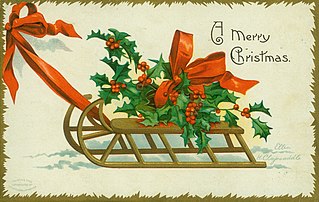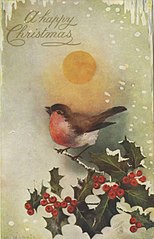
Holly, with its dramatic red berries, and ivy are two more evergreen symbols of Christmas that predate the Christian celebration. Romans decorated their homes with holly and ivy during Saturnalia, a year end festival honoring Saturn. Celts used the plants during the winter solstice.
Both plants stand out during bleak winter days, with or without a blanket of snow, and both can provide forage for animals. Over time, holly became a sacred plant to the Druids who equated it with fertility and eternal life. Bringing holly into the home brought good luck, and placing it around the door, often as a wreath, prevented evil spirits from entering.
Ivy also became a symbolic plant associated with rebirth, romance, and fertility. Compared to holly, ivy’s foliage is weak and entwining.
Hence, holly was seen as a masculine plant, and ivy as feminine. Songs about holly and ivy created a contest between the two to determine if the master or mistress would rule the family.

THE CONTEST OF THE HOLLY & THE IVY
in which Holly takes the victory and Ivy is eaten
Refrain: Nay, Ivy, nay, it shall not be I wis;
Let Holly have the mastery, as the manner is.
Holly stands in the hall, fair to behold:
Ivy stands without the door, she is full sore a-cold.
Holly and his merry men, they dance and they sing,
Ivy and her maidens, they weep and they wring.
Ivy hath chapped fingers, she caught them from the cold,
So might they all have, aye, that with Ivy hold.
Holly hath berries red as any rose,
The forester, the hunter, keep them from the does
Ivy hath berries black as any sloe;
There come the owl and eat him as she go
Holly hath birds a fair full flock,
The nightingale, the popinjay, the gentle laverock.
Good Ivy, what birds hast thou?
None but the owlet that cries how, how.

COME, YOU SHALL BE CROWNED FAVORS
In which Ivy is crowned with victory
She is the worthiest in the world
Those who say otherwise are wrong
And she is worthy to bear the crown
Come, you shall be crowned
Ivy is soft of speech, and mild
In the face of ills, she is relief
He who attains her is blessed indeed
Come, you shall be crowned
Ivy’s hue is brilliant green
Among trees, she is the most exalted
And now the truth I prove to you
Come, you shall be crowned
Ivy bears berries of deepest black
God grant that we all get to heaven at last
For in that place we shall nothing lack
Come, you shall be crowned
THE HOLLY & THE IVY

In the late 19th century, Cecil Sharp traveled around England collecting folk songs. He first heard The Holly and the Ivy sung by a Mrs. Mary Clayton, and published it in 1911.
In this song, Holly remains dominant over Ivy, but his importance is superseded by Christian symbolism.
The Holly and the Ivy,
When they are both full grown,
Of all trees that are in the wood,
The Holly bears the crown:
Refrain: O, the rising of the sun,
And the running of the deer
The playing of the merry organ,
Sweet singing in the choir.
The Holly bears a blossom,
As white as lily flow’r,
And Mary bore sweet Jesus Christ,
To be our dear Saviour:
The Holly bears a berry,
As red as any blood,
And Mary bore sweet Jesus Christ,
To do poor sinners good:
The Holly bears a prickle,
As sharp as any thorn,
And Mary bore sweet Jesus Christ,
On Christmas Day in the morn:
The Holly bears a bark,
As bitter as any gall,
And Mary bore sweet Jesus Christ,
For to redeem us all:
The Holly and The Ivy emphasizes that in the contest between Holly and Ivy, the male Holly is triumphant. It also contains the essence of the Christian message — Holly’s blossom is white for Christ’s purity; Holly’s red berry for Christ’s blood; the sharp, prickly leaves for the Crown of Thorns, and the bitter bark for the drink offered to Christ on the cross.
🎄🎄🎄
Sled with holly, 1907. Public Domain.
Holly by AnemoneProjectors.
Ivy. Public Domain.
Holly Branch with Bird. Public Domain.
Medieaeval Baebes: Veni Coronaberis
Sam Abramson.” Why do we decorate with holly at Christmas?” How Stuff Works.
David Beaulieu. “The Holly and the Ivy: History Behind the Song.” The Spruce. Nov. 24, 2019.

Sandra Wagner-Wright holds the doctoral degree in history and taught women’s and global history at the University of Hawai`i. Sandra travels for her research, most recently to Salem, Massachusetts, the setting of her new Salem Stories series. She also enjoys traveling for new experiences. Recent trips include Antarctica and a river cruise on the Rhine from Amsterdam to Basel.
Sandra particularly likes writing about strong women who make a difference. She lives in Hilo, Hawai`i with her family and writes a blog relating to history, travel, and the idiosyncrasies of life.

